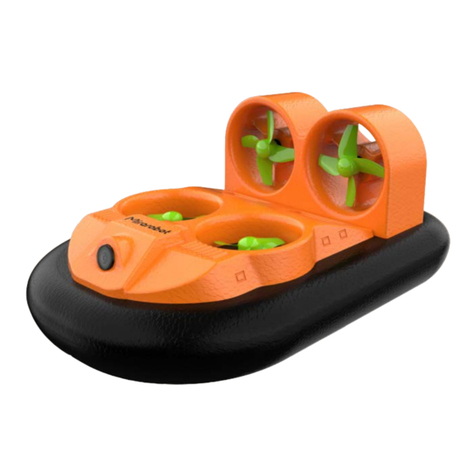
increase slightly and the aircraft will pitch forward until forward flight attitude has been
achieved. It
is
normal to have some slight oscillations
in
pitch as the aircraft transitions
into forward flight. While
in
stability flight mode the motors use differential thrust to
provide yaw control.
NOTICE: Always fly
in
a clear and open area. While the transition from multirotor to
forward flight does not require much space, you will not
be
able to change the
direction of flight until the transition is complete. NEVER attempt to transition to
forward flight indoors
in
anything but a large open space such as a large gymnasium.
To transition to multirotor flight from forward flight, reduce the airspeed and
change the flight mode switch on your transmitter to the multirotor flight position. The
throttle will increase slightly and the aircraft will pitch
up
until it reaches a multirotor
attitude.
NOTICE: If you are flying
in
wind, the aircraft will
be
blown downwind after it
transitions to vertical mode.
Transition to vertical flight at low throttle will cause the aircraft to descend until more
throttle
is
applied.
Stability and Aero Forward Flight
Fly the aircraft and trim it for level flight per the
In
Flight Trimming section. The aircraft
flies
in
a very similar manner
in
forward flight to any other fixed-wing aircraft. It
is
capable of a wide range of aerobatic maneuvers, including loops and rolls.
Additionally, the differential thrust of the motors allows for unique spinning and
tumbling maneuvers.
Hand Launching
Hand launching is preferred when flying
in
higher winds or when vertical takeoff may
not
be
possible.
1.
Lower the throttle to the lowest setting. The aircraft will not arm unless the
throttle is fully lowered.
2.
Power
on
the model normally, allowing it to initialize completely.
3.
Set the flight mode switch to stability mode.
4. Hold the aircraft horizontal, with a firm grip at the rear-center of the airframe,
being careful not to interfere with the control surfaces.
5.
Arm the aircraft
by
pressing and holding the motor arm/disarm switch. When the
aircraft is armed
in
either stability or aero mode, the control surfaces will cycle
left and right and then return to center. The aircraft is now armed
in
stability
mode. The motors are armed and will run with any throttle input.
6. Increase the throttle to approximately 50-75%.
7.
Give the aircraft a light, underhand toss into the wind.
Landing
The preferred method of landing
is
to transition the aircraft into multirotor flight mode
and bring it into a low hover. Slowly lower the throttle to descend to a soft landing.
Immediately activate throttle cut or press and hold the motor arm/disarm switch to
stop the motors when the aircraft touches down. Failure to stop the motors may cause
the aircraft to skip or hop across the ground if the flight controller does not recognize
the aircraft has landed. 15
It is possible to land the aircraft
in
forward flight as well when conditions dictate
it,
such as
in
high wind. To land while
in
a forward flight mode, turn the aircraft into the
wind and lower the throttle to decrease the forward speed. Fly the aircraft to
approximately 6 inches (15cm) or less above the runway, using a small amount of
throttle for the entire descent. Keep the throttle
on
until the aircraft is ready to touch
down.
Just before touch down, keep the wings level and the airplane pointed into the wind.
Gently lower the throttle while easing back
on
the elevator
to
bri
ng
the aircraft to touch
down
on
the runway as slowly and gently as possible. Using stability mode for
landings will help stabilize the aircraft.
IMPORTANT: The aircraft will automatically disarm after sitting for approximately 3
seconds with
no
throttle, no control inputs or aircraft movement.
The average flight time with a mixture of multirotor and forward flight using the
recommended 900mAh flight battery is approximately 8 minutes.
After landing disconnect and remove the Li-Po battery from the aircraft to prevent
trickle discharge. Charge your Li-Po battery to about half capacity before storage.
During storage, make sure the battery charge does not fall below 3V per cell.
NOTICE: If a crash
is
imminent, activate the throttle cut to immediately stop the
motors to reduce the possibility ofdamage to the airframe and electronic components.
NOTICE: Crash damage
is
not covered under warranty.
NOTICE: If a crash
is
imminent, activate the throttle cut to immediately stop the
motors to reduce the possibility ofdamage to the airframe and electronic components.
NOTICE: Crash damage is not covered under warranty.
Propeller Inspection
Inspect the propellers after every flight. Check for breaks, cracks or bends of the
propeller tips. Even minor damage may affect the flight performance ofthe aircraft and
may cause unwanted yaw under throttle
in
forward flight. If any damage is found,
replace the propeller before attempting additional flights.
Low Voltage Cutoff ( LVC )
When a
Li
-
Po
battery is discharged below 3V per cell, it will not hold a charge. The
aircraft's ESC protects the flight battery from over-discharge using Low Voltage Cutoff
(LVC). Once the battery discharges to approximately 3.45V per cell, the LVC will
reduce the power to the motor
in
order to leave adequate power to the receiver and
servos to land the aircraft.
How the LVC function is indicated
is
dependent
on
which flight mode is active. While
in
vertical mode, the motor power will decrease. The aircraft will respond sluggishly to
throttle and will gradually not
be
able to gain or hold altitude.
When the motor power decreases, land the aircraft immediately and replace or
recharge the flight battery.
While
in
either of the forward flight modes, the motors will cut off briefly and power
back on. If the motors cut off or surge
in
power, land immediately and replace or
recharge the flight battery. Transition back to vertical mode
is
possible if done early
in
16




























